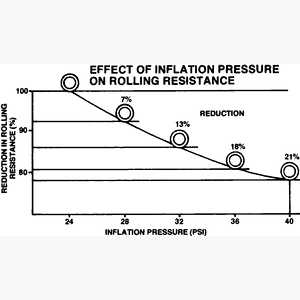Quote:
Originally Posted by arcosine

OK, young tire engineer......
|
I'm sorry, but I do not think anyone I know would call me young.
Quote:
Originally Posted by arcosine

...... I'll ride my road bike hpv with skinny high pressure tires and you ride a mountain bike with big fat low pressure tires and we see who is faster on the road. Of course we don't have to do this because we already know who would win......
|
Would you win because my tires are wider, or because my tires are using lower pressure? What would happen if we used the same inflation pressure? (assuming everything else is the same.)
Quote:
Originally Posted by arcosine

.........So I'll ask your expertize, Which tire would give the best MPG:
185/65R15 at 35 psi
165/80R15 at 44 psi
185R15 at 35 psi
|
Let's see if I can work this through.
First, the load on the tires isn't specified, but let's assume it is the same - like what would happen if all 3 of these sizes was applied to the same vehicle. I'm going to express this as Rolling Resistance Coefficient (RRC).
According to the Smithers report, a 185/65R15 has an RRC value of ..... well, they didn't test that size (or any of the other sizes), but we can make a reasonable estimate based on the data that is available. If you run a regression analysis of the data, you get a formula for the 3 numbers that constitute a tire size. I did that in the web page I earlier posted. Here is that page again:
Barry's Tire Tech
The Smithers report doesn't say what test method they used. So both the load and the inflation pressure are unknown. But if we assume they used a standard RR test, they would have used some percentage of the rated load and some inflation pressure. The inflation pressure would be the same for each tire regardless of tire size. The load would vary depending on what the rated load would be.
Let's assume that the pressure was the rated 35 psi (a pretty good assumption given that most of RR tests are run at the rated pressure.)
Given all that, the regression equation would give you the following results (the formula is on the web page):
185/65R15 = 0.001124 RRC (35 psi)
165/80R15 = 0.001108 RRC (35 psi) - note: This is specified at 44 psi so we need to recalculate the value - which I will do below.
The only source I know of in translating rolling resistance between different pressures is this: SAE Paper 800087 - The Effect of Inflation Pressure on Bias, Bias-Belted, and Radial Tire Performance - by B. L. Collier and J. T. Warchol, B. F. Goodrich, February, 1980
I summarized parts of this paper here:
Barry's Tire Tech
Unfortunately, I am not allowed to publish all of it - and one of the unpublished parts is the change in rolling resistance as a function of inflation pressure. But I did extract a graph derived from that paper:

This doesn't show the change from 35 psi to 44 psi (+9 psi), but if we use 32 psi to 40 psi (+8 psi), then the RR changes from 113% to 121% of the value at 24 psi (which would have been the rated pressure of the type of tires used in the test). So 121/113 = 107% - a 7% improvement.
So if we decrease the RRC value to 93%, we get 0.001030 RRC.
OK, the next size:
185R15 = 0.001059 The trick here is knowing that the way this tire size is stated implies an aspect ratio of 82.
Summarizing:
185/65R15 = 0.001124 RRC (35 psi) Assigned the value of 100%
165/80R15 = 0.001030 RRC (44 psi) 92%
185R15 = 0.001059 RRC (35 psi) 94%
Caution: The RRC values assume the tires are the same as in the Smithers report - Goodyear Integrity's (my best guess). If you want to compare the effect tire size (and inflation pressure) has, you should use the percentages stated.
Does this say that narrower tires give better RR? No, there's a lot of different variables in the mix. We have different inflation pressures, different aspect ratios, different widths, etc. - all of which are going to affect the results.
If we complicate that further by trying to compare different manufacturer/design combinations (according to Smithers a range of 60%) - well, I think it is easy to see why it is very difficult for an individual consumer to draw conclusions based on a change they might make. Not to mention that worn tires give different RR than new tires (all other things being equal).
When it comes to RR of tires, it gets pretty complicated pretty fast. If the goal is improving fuel economy, it pays to be very careful about comparing apples to apples.